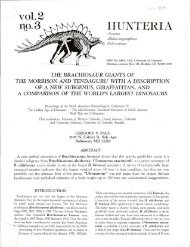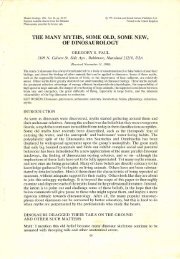Dinosaur models: the good, the bad, and using - Gregory S. Paul
Dinosaur models: the good, the bad, and using - Gregory S. Paul
Dinosaur models: the good, the bad, and using - Gregory S. Paul
Create successful ePaper yourself
Turn your PDF publications into a flip-book with our unique Google optimized e-Paper software.
140 Dinofes~ International Proceedings<br />
in mass at <strong>the</strong> front or back end of an animal can have a major<br />
effect upon <strong>the</strong> center of gravity because of <strong>the</strong> lever effect.<br />
Estimates of <strong>the</strong> pressure exerted on <strong>the</strong> ground by <strong>the</strong> under<br />
surfaces of dinosaur feet in Alex<strong>and</strong>er (1989) may be as excessive<br />
as <strong>the</strong> mass estimates used in <strong>the</strong> study.<br />
St<strong>and</strong> Up Sauropods <strong>and</strong> Stegosaurs<br />
Some researchers assert that big sauropods were too heavy to<br />
st<strong>and</strong> on two legs, including Jensen (1988) who used mass estimates<br />
that were too high for <strong>the</strong> specimens cited. Alex<strong>and</strong>er<br />
(1989) concluded that sauropod hindlimbs were strong enough<br />
to st<strong>and</strong> up on, even though <strong>the</strong> mass estimates he used were<br />
sometimes too high. That sauropods were less bulky than often<br />
thought aids <strong>the</strong> hypo<strong>the</strong>sis that <strong>the</strong>y reared up.<br />
This study shows that <strong>the</strong> legs of dicraeosaurs, Apatosaurus<br />
<strong>and</strong> Stegosaurus <strong>and</strong> legs were unusually robust for animals of<br />
<strong>the</strong>ir mass, <strong>and</strong> so little of this strength was in <strong>the</strong> forelimb (in<br />
both <strong>the</strong> femur was one third thicker than <strong>the</strong> humerus) that<br />
hindlimb strength was as high as in bipeds. Additional bipedal<br />
features of Stegosaurus, dicraeosaurs <strong>and</strong> apatosaurs include unusually<br />
short arms <strong>and</strong> trunks, large sacrals <strong>and</strong> hips, <strong>and</strong> heavy<br />
tails. Giffin (1990) observed that neural control of <strong>the</strong> forelimbs<br />
is poorly developed in sprawling lizards, short armed bipeds,<br />
Stegosaurus <strong>and</strong> apatosaurs, arid <strong>the</strong> same appears to be true of<br />
dicraeosaurs. Giffin suggested that <strong>the</strong> dinosaurs' arms were not<br />
erect, but stegosaur <strong>and</strong> sauropod arms could not articulate in a<br />
sprawling posture (<strong>Paul</strong>, 1987). It is more probable that dicraeosaurs,<br />
Apatosaurus <strong>and</strong> Stegosaurus arms were weak <strong>and</strong> poorly<br />
controlled because <strong>the</strong>y used <strong>the</strong>m less than previously realized,<br />
perhaps because <strong>the</strong>y often walked on <strong>the</strong>ir strong hindlimbs<br />
alone.<br />
Run <strong>Dinosaur</strong> Run<br />
Faster moving animals need stronger limb bones that slower<br />
forms, so one way to assess <strong>the</strong> "athletic" ability of an extinct<br />
form is by comparing its limb strength vis-a-vis modem mammals<br />
(Alex<strong>and</strong>er, 1989). This method is highly dependent upon<br />
accurate mass estimates (Farlow, 1990). Alex<strong>and</strong>er calculated<br />
that a 12 tonne Diplodocus <strong>and</strong> a 34 tonne Apatosaurus were<br />
too weak-limbed to run. The last mass estimate is too high, <strong>and</strong><br />
apatosaur legs were strong enough to run on (but lack of a proper<br />
limbs <strong>and</strong> feet prevented <strong>the</strong>m from doing so [<strong>Paul</strong>, 1987]).<br />
Alex<strong>and</strong>er calculated that <strong>the</strong> legs of 6 tonne Triceratops were<br />
strong enough to run on, this is plausible because <strong>the</strong> weight<br />
estimate is accurate <strong>and</strong> ceratopsid limbs <strong>and</strong> feet were suitable<br />
for running (<strong>Paul</strong>, 1987). Alex<strong>and</strong>er <strong>and</strong> Farlow et al. (1995)<br />
calculated that two different Tyrannosaurus specimens (estimated<br />
mass 8 <strong>and</strong> 6 tonnes respectively) were too weak limbed to<br />
run. The model used by Farlow et al. (1995) has errors (Figure<br />
3). Even so, <strong>the</strong> restored volume appears to be accurate because<br />
it is a little lower than that of <strong>the</strong> larger specimens, so its mass<br />
was probably 5.4 tonnes. Corrected mass for <strong>the</strong> specimen used<br />
by Alex<strong>and</strong>er is less than 5.7 tonnes (Figure 3), at that value its<br />
limb bones appear to have been strong enough (Farlow, 1990)<br />
to bear <strong>the</strong> running gait its limbs were designed for (<strong>Paul</strong>,<br />
1988b).<br />
<strong>Dinosaur</strong> Brains<br />
Many dinosaurs are famed for <strong>the</strong>ir "small" brains, o<strong>the</strong>rs for<br />
being intellectually well endowed. Determining how big brained<br />
an animal was involves measuring <strong>the</strong> size of <strong>the</strong> brain, <strong>and</strong><br />
plotting it as a function of body mass. Errors in estimating <strong>the</strong><br />
latter have skewed <strong>the</strong> results. For example, a brachiosaur was<br />
plotted on <strong>the</strong> assumption that its owner weighed 78 tonnes<br />
(Hopson, 1980), but <strong>the</strong> skull belongs to a large juvenile of<br />
"only" 16 tonnes.<br />
FIGURE8-Profiles comparing <strong>the</strong> size of <strong>the</strong> body <strong>and</strong> nasal passage (in<br />
white) in a juvenile tyrannosaur (top) <strong>and</strong> elephant bird (bottom), to<br />
same scale, scale bar equals 1 m. Although <strong>the</strong> animals are roughly<br />
similar in bulk, <strong>the</strong> nasal passage of <strong>the</strong> dinosaur is larger than <strong>the</strong><br />
bird, <strong>and</strong> could <strong>the</strong>refore contain equally well developed nasal scrolls.<br />
<strong>Dinosaur</strong> Noses<br />
Ruben et aI. (1995) suggested that <strong>the</strong> nasal passages of predatory<br />
dinosaurs were too small to accommodate <strong>the</strong> bird-like<br />
nasal "scrolls" that may be necessary for a high metabolic rate.<br />
This hypo<strong>the</strong>sis can be tested by estimating <strong>the</strong> mass of dinosaurs<br />
<strong>and</strong> birds of similar size, <strong>and</strong> seeing if <strong>the</strong> nasal passage<br />
of <strong>the</strong> former really is smaller than that of <strong>the</strong> latter; Figure 8<br />
shows that a young tyrannosaur has a larger nasal passage than<br />
a giant bird of about <strong>the</strong> same weight, so Ruben's hypo<strong>the</strong>sis is<br />
contradicted.<br />
You Cannot Always Believe What You Perceive<br />
<strong>Dinosaur</strong>s did not always appear to be <strong>the</strong> size <strong>the</strong>y actually<br />
were. A homed ceratopsid looks smaller than a duckbilled hadrosaur<br />
or tyrannosaur of equal mass because it lacks <strong>the</strong> long<br />
tails <strong>and</strong> legs of <strong>the</strong> latter two, <strong>and</strong> <strong>the</strong> tall vertebral spines of<br />
<strong>the</strong> duckbill. The sauropod Amargasaurus looks about as large<br />
as Dicraeosaurus, which looks almost as large as Opisthocoelicaudia,<br />
but closer examination shows that <strong>the</strong> ribcage of <strong>the</strong><br />
first is much smaller than its dicraeosaur relative, which in turn<br />
is less voluminous than <strong>the</strong> last sauropod, which lacks tall spines<br />
that would inflate its size. The big plates of Stegosaurus give it<br />
a profile as big as a ceratopsid two or three times as massive.<br />
Being Huge in <strong>the</strong> Oceans is Good, Being Huge on L<strong>and</strong> is<br />
Better<br />
A common cliche asserts that giant dinosaurs were misplaced<br />
on l<strong>and</strong>, <strong>and</strong> that evolution more correctly placed whales in<br />
buoyant oceans. The reality is that super-sauropods were not<br />
only as big as whales, but thrived from about 150 to 65 Myr<br />
ago. Similarly massive whales appeared only 10 Myr ago, <strong>and</strong><br />
<strong>the</strong> largest examples date back only a few Myr. So far <strong>the</strong> time<br />
tally favors <strong>the</strong> l<strong>and</strong> giants.









